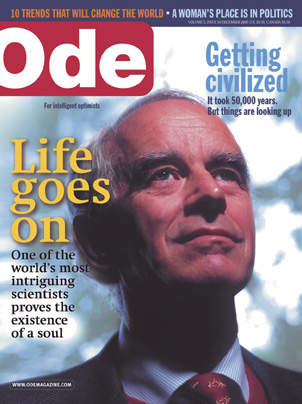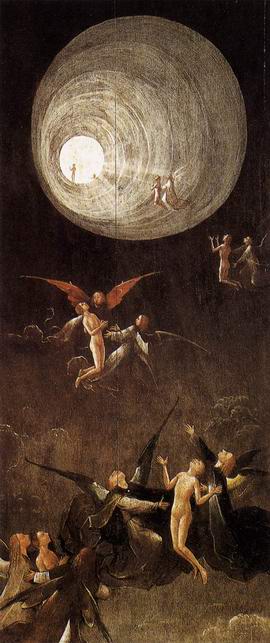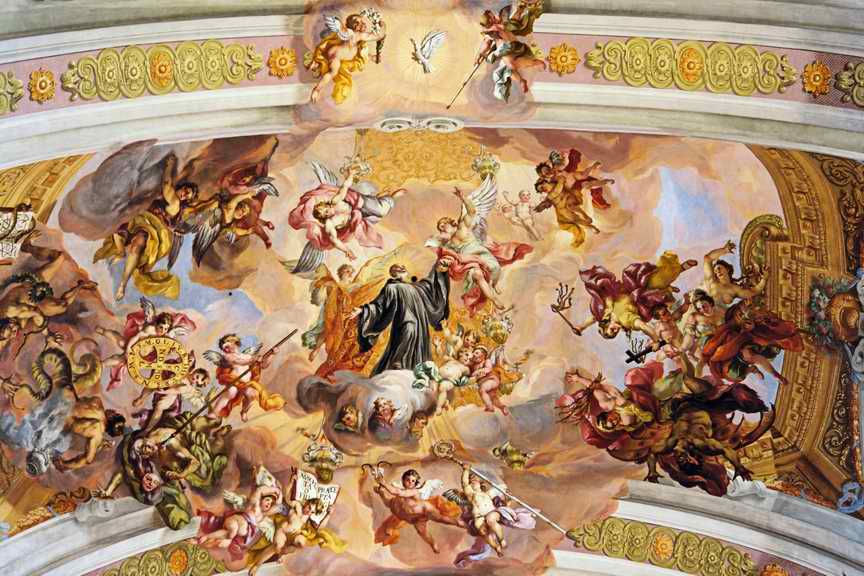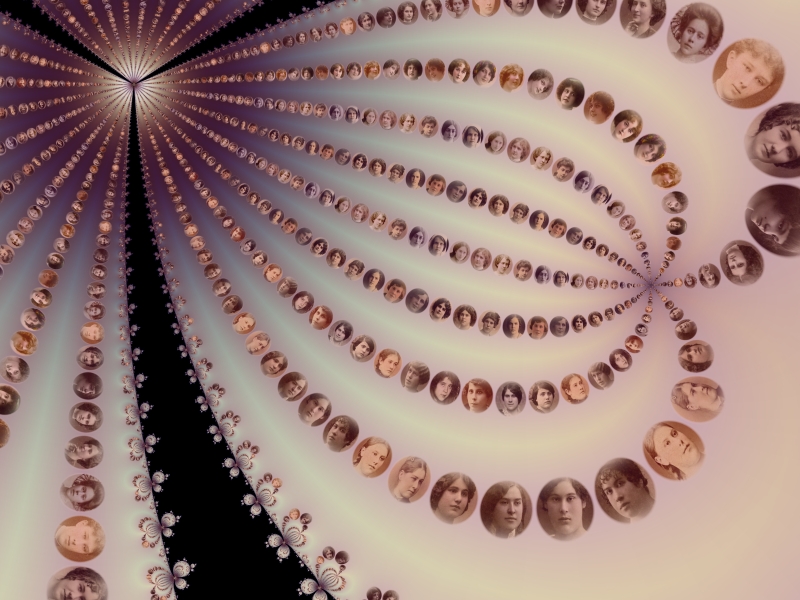(Also see my 2012 addendum (at the very end) on neurosurgeon Eben Alexander's report that Heaven is Real.)
Are near death experiences (NDEs) real? Well, the reports are real .
Some people earnestly believe they had a profound experience traveling outside their bodies, meeting deceased relatives, reviewing their lives, and are deeply transformed thereby.
The real question is "how should we interpret their NDEs?"
Did they actually travel outside their bodies and meet the souls of dead relatives while their EEGs showed they were brain-dead? My answer is no — no way!

Gustave Dore's depiction of the highest heaven, described by Dante Alighieri in the Paradiso (Wikimedia Commons.)
Forever the hard-bitten skeptic, your roving reporter was recently shoved by fate (which famously works “synchronistically” and in strange ways)into a delightful three hour hike and dinner with one of the world's top researchers of NDEs, Dutch cardiologist Dr. Pim Van Lommel, whose book Consciousness Beyond Life was released in the USA in 2010.
I was attending the wonderfully eclectic TSC Conference (Toward a Science of Consciousness) in Tucson, sponsored by the University of Arizona. Since my main interest has always been the neurobiology of consciousness, that was the main draw. Among the banner invitees were Professors Antonio Damasio (emotional brain) , Marcus Raichle (default networks - wandering thoughts), Christof Koch (NCC and Jennifer Aniston cells), Karl Deisseroth (optogenetic, laser-controlled mice) — all A-list neuroscientists.
Next, were the philosophers of mind including the widely quoted David Chalmers (the easy versus the hard problem of consciousness), Harvard's Eugene Taylor, and consciousness theorist Bernard Baars (global workspace). Then, there were the computer scientists: Dharmendra Moda (IBM's Connectome Project) and Ben Goetzel( AI guru and Singularitarian), who, like me, are trying to determine if you can do it in silicon.
But that's only half the ideation of the TSC Conference — then it gets, shall we say, increasingly speculative — far out, man!
Enter the researchers of transformative experiences (Cassie Vieten) and enlightenment (Jeffery Martin); add in those seeking to establish a basis for consciousness in quantum mechanics (Stuart Hameroff (famously joined by Nobelist Roger Penrose); further mix in those studying meditation and psychopharmacology, fold in ZA Choeje Rinpoche (the “reincarnation of the 6th Dali Lama”), and top it all off with sci-fi writer Rob Sawyer and some sixties-style art and song and you’ve got an informative and entertaining week in the Arizona sun — Burning Man for eggheads or Society for Neuroscience on LSD.

Sabino Creek in Tucson, Arizona
Now, back to Dr. Pim Van Lommel and NDEs. After touring the verdant, riparian Sabino Canyon in the Tucson desert, I have an hour to kill before dinner. I want to hike more, but there's no one around. Suddenly, appearing ex vacuo is Julia Mossbridge, a psych post-doc from Northwestern — a willing hiking partner. As we hunt for directions for our desert stroll, she spies Dr. Van Lommel and asks him to join us. (People ask me how I decide what to write about. I don't. The stories find me!)
As we head out amidst the sand and cactus, Pim (Van Lommel) tells me he was the organizer and lead author on a 2001 Lancet article on NDEs, the largest, most detailed study to date .
That study made international headlines, and Pim has lectured about it worldwide. Furthermore, the Dutch edition of his book Consciousness After Life already sold 100,000 copies in his native Holland alone and thousands more in Germany.

Proves the existence of the soul! (?) That's Ode selling magazines.
Dr. Van Lommel is more circumspect.
Pim’s study helped inspire another large multi-institution study of NDE’s now going on in the USA and the UK. That's the Human Consciousness Project whose lead researcher, Dr. Sam Parnia, was interviewed by MSNBC News on NDEs .
Over the next three hours we discussed many of the details of Pim's study and of the NDE phenomenon itself. Here I paraphrase and summarize our conversation.
RLB: Tell me about the study!
PVL: I organized this study, and then conducted it over the course of ten years. I'm a cardiologist, now retired. My father was a neurologist. (Pim is age 67 and is in great shape. He, like me, loves hiking and the outdoors.)
The study included 344 patients who had experienced cardiac arrest. Of those, 62 patients (18%) had an NDE (near death experience).
RLB: Of the 62 patients who experienced an NDE, were the experiences all the same?
PVL: There were many elements they had in common, for example, moving toward a bright light and floating out of one's body, but most NDE patients did not have all the elements of a deep NDE.
(I’ve reproduced Table 2 from his 2001 Lancet paper to show the elements that characterize an NDE. These elements comprise the Weighted Core Experience Index WCEI developed in 1980 by Ken Ring, a well known NDE researcher.
The table also shows the approximate sequence of events in a deep (full) NDE.
NDE patients; total N = 62

Ascent of the Blessed by Hieronymous Bosch (wiki commons)
RLB: Before we go further, I must admit I'm a huge skeptic of supernatural and paranormal claims. I believe your patients reported these experiences, but attributing objective reality to these claims is hard to swallow.
PVL: When you say you're a skeptic, do you mean you're completely closed off to this possibility?
RLB: No, as a scientist, I'm always open to new hypotheses, but, if you're attributing objective reality to the experiences of these patients, then you’re making several extraordinary claims. One of my favorite sayings, popularized by Carl Sagan, is this:
Extraordinary Claims Require Extraordinary Proof .
RLB: I've got a number of hard questions and issues that need to be addressed. (Here, as always, the trick is getting to the heart of the matter while remaining polite.)
PLV: Go right ahead. I've been asked these questions by many physicians throughout the world.
RLB (continuing): What were the diagnoses in these patients?
PVL: Almost all had myocardial infarctions. (An MI is doctorspeak for a heart attack, death of heart muscle caused by sudden blockage of a coronary artery.
RLB: And what was the state of their cerebral perfusion (blood flow to the brain)?
PVL: Stopped completely. These patients were in ventricular fibrillation (VF). There was no cardiac output. (Without blood flow, the brain stops functioning within seconds. )
RLB: (Here, we discussed details of their cardiac arrests and resuscitations. Pim assures me that cardiac rhythms were continuously monitored and recorded. Without going into details, one piece of the puzzle is how long the NDE patients' brains were without blood flow.
(No physicians - not even most cardiologists - have more experience in dealing with acute cardiac arrests than emergency physicians. All of us career ER doctors have treated hundreds of these cases. As front-line physicians, it's the ER docs who are there 24 by 7 by 365 where the action is. I also taught Advanced Cardiac Life Support (ACLS) for over a decade — this is my home turf.)
In my experience, even though VF may predominate in a given arrest, it usually doesn't persist for more than a minute or so, although it certainly can. (In the ER these patients are being intensively treated. They're being shocked every 10 -15 seconds, and various drugs are being administered (epinephrine, lidocaine, procainamide, amiodarone, etc.)
In a typical patient VF is present, intermittently interspersed with ventricular tachycardia (VT) and other partially perfusing tachycardias. MI patients also nearly always get huge doses of morphine and other opiates and doses of sedatives.
Reviewing Table 3 in the Lancet paper , I see that the average duration of the cardiac arrest was 4 minutes.
I'ts likely that there was intermittent cerebral (brain) perfusion during that time.
I hammer him on this point, but he insists that the patients were without blood flow during their arrests. This crucial point cannot be resolved from the data presented in the Lancet paper (a crucial flaw!)
Further examining Table 3, I see that only 10% of the patients required intubation (putting a plastic tube into their tracheas (windpipes)) to assist their breathing. Intubation is a very high priority in a code blue patient. It can be quite difficult, but it can be life-saving. The whole team breathes a sigh of relief after the ER doc has placed the tube into the patient's trachea. That only 10% of the patients required intubation reinforces my notion that these were brief arrests in which cerebral perfusion was adequate to support some mentation/ cognition (albeit altered).)
RLB: How do you know there was no cerebral perfusion?
PVL: Besides the fact that the patients were in VF, their EEGs were flat.
RLB: (I ask him many questions about the EEGs (electroencephalograms). Typically, an EEG is an elective study that a neurologist performs when a patient is suspected of having seizures. A dozen or more electrodes are placed on the scalp to monitor the brain's electrical activity. Getting the electrodes to stick to the scalp is difficult without shaving the scalp. I've never seen an EEG done during a cardiac arrest. These may be done in the ensuing weeks in a comatose patient to ascertain whether the patient is brain-dead and can be disconnected from life support.
PVL's answers to my questions about EEG monitoring were vague, and there is no relevant data in the Lancet paper. I suspect that EEG monitoring was only done on occasional patients, as above.
Even if an EEG is flat-line that does not mean there is no cerebral activity. The EEG is only monitoring local field potentials in the cortex — the outer few millimeters of brain tissue. There can still be normal activity in subcortical areas.
RLB: So, basically you're saying these patients had no cardiac output, no cerebral perfusion, and a flat-line EEG but were still capable of experiencing NDEs with all their elaborate visual images — viewing their own resuscitation from above, seeing deceased relatives, reviewing their lives ? ("God, no!" I'm thinking.)
PVL: Yes! They're having those experiences independent of and despite their brains have ceased to function.
RLB: (I repeat my intense skepticism.) That is quite an extraordinary claim and (if true) requires a revision of our thinking about neuroscience, physics, and consciousness.
PVL: Yes!

Pim with philosopher David Chalmers and me — consciousness altered, but intact
RLB: Are you religious and were many of the patients religious?
PVL: I'm not religious but many of the patients are. However, the number of religious patients in the NDE and control groups were not significantly different.
RLB: My view is that your patients are genuinely reporting their experiences but those experiences are hallucinatory. Consider the work of Henrik Ehrsson (a Swedish neuroscientist, who joined Pim and me for dinner.) Prof. Ehrsson and others have shown that they can synthetically induce some elements of an NDE-like out of body experience (OOBE) by artificially stimulating some parts of the cortex.
PVL: Yes, Henrik has shown that but you must distinguish those illusory experiences from the veridical experiences in my NDE patients .
Consider these two examples (he continues) ...
First, is a man who had a cardiac arrest and was in a deep coma during the resuscitation. Prior to his being intubated, a nurse removed his dentures and put them in a cup in the bottom drawer of the crash cart. A week later when that nurse reintroduced herself to him in the ICU, the man said, I remember you. You're the nurse who took out my dentures and put them in the drawer of that cart. (This story is also told in the Lancet paper.)
Second, Pim tells me the story of a woman who had an NDE during which she encountered a stranger who told her facts that she had never heard. When she later recovered, her family verified the facts and identified the stranger, whom she had, indeed, never met.
(The NDE literature is replete with stories similar to these in which patients hover over their bodies in the resuscitation room and observe details of procedures done on them and instruments used, all while being comatose. These stories are part of the essential evidence which persuades adherents like Dr. Van Lommel that souls and consciousness have an existence independent of normal brain functioning.)
RLB: These are extraordinary claims you're making that require fundamental revisions to neuroscience, to physics, and to our view of the Universe.
PVL: Yes. Fundamental revisions are required.
RLB: All I can do is repeat my assertion that all conventional explanations must be ruled out before invoking these extraordinary claims.
(I mention a well-known article that British psychologist Sue Blackmore wrote called Why I Have Given Up (on parapsychology ) . Needless to say, Pim and Sue do not see eye to eye on these issues.
Even though I (RLB) still believe that the patients' brains were producing these illusory perceptions, the fact remains that the experiences themselves and their aftermath are quite interesting and deserving of study.
PVL: Yes. We interviewed the NDE patients (and a control group) initially in the hospital, two years later, and eight years later. Almost all the NDE patients had profound transformations in their personalities. Relative to controls, the NDE patients underwent several positive changes: a heightened appreciation of ordinary things, an increase in empathy, a decreased fear of death, increased involvement with their families, and an increased interest in others, and in the meaning of life.

Triumphal Ascent to Heaven by Johann Michael Rottmayr (wiki commons)
(This is shown in Table 4 from the Lancet study
RLB: I'm aware of Sam Parnia's on-going multi-institution study of NDE (The Human Consciousness Project). Your study must've inspired him to undertake it.
PVL: Perhaps. I've chatted with Sam.
RLB: It will be informative to see if his results agree with yours .
(One of the interesting features of Parnia's study is that high shelves near the ceilings were constructed in the resuscitation rooms. Images are placed on those shelves that might be viewable, if the patient, while having an OOBE, is able to see them and accurately report what he sees.)
(Understanding how the brain produces consciousness is one of the great mysteries of science . Until it's solved, it seems that alternative theories of consciousness including souls floating in an after-life will continue to be promulgated. Meanwhile, my faith in neuroscience remains unshaken. )
ADDENDUM 2012 — This month there's been a tsunami of publicity about an experience that neurosurgeon Eben Alexander had while in a week-long coma hospitalized with meningitis.
As with other NDE experiencers, I have little doubt that he's giving a true account of what he experienced and believes. However, my interpretation of his experiences is this — Real? Forget it! This was an elaborate hallucination!
The brilliant Sam Harris states it like this. "If Heaven is Real — as stated on a recent cover of Newsweek — Eben Alexander's experience provides no evidence of that.
But Sam Harris's article contains a must-read quote from the late Terence McKenna describing a prototypical DMT trance. (In comparison, Eben Alexander's heaven seems like a bowling alley compared to the Taj Majal.)
Reading Terrence McKenna (whom I listened to first-hand in the sixties in San Francisco — that's just between you and me — we now grasp some of the experienced realities of William Blake, Walt Whitman and Philip K Dick (Blade Runner, Total Recall.)
The magic is happening in that 1½ quart organ between your ears.

Julia Set Field Lines : original work by artist, mathematician Gert Buschmann.
Under the influence of DMT, the world becomes an Arabian labyrinth, a palace, a more than possible Martian Jewel, vast with motifs that flood the gaping mind with complex and wordless awe. Color and the sense of a reality-unlocking secret of other times, and of one's own infancy, and of wonder, wonder, and more wonder. It is an audience with the alien nuncio. In the midst of this experience, apparently at the end of human history, guarding gates that seem surely to open on the howling maelstrom of the unspeakable emptiness between the stars, is the Aeon.
The Aeon, as Heraclitus presciently observed, is a child at play with colored balls. Many diminutive beings are present there - the tykes, the self- transforming machine elves of hyperspace. Are they the children that are destined to be father to the man? One has the impression of entering into an ecology of souls that lies beyond the portal of what we naively call death. I do not know. Are they the synthetic embodiment of ourselves as the Other, or of the Other as ourselves? Are they the elves lost to us since the fading of the magic light of childhood? Here is a tremendum barely to be told, an epiphany beyond our wildest dreams. Here is the realm of that which is stranger than we can suppose. Here is the mystery, alive, unscathed, still as new for us as when our ancestors lived it fifteen thousand summers ago. The tryptamine entities offer the gift of new language, they sing in pearly voices that rain down as colored petals and flow throught the air like hot metal to become toys and such gifts as gods would give children. The sense of emotional connection is terrifying and intense. The Mysteries revealed are real and if ever fully told will leave no stone upon another in the small world that we have gone so ill in.
This is not the mercurial world of the UFO, to be invoked from lonely hilltops; this is not the siren song of lost Atlantis wailing through the trailer courts of crack-crazed America. DMT is not one of our irrational illusions. I believe that what we experience in the presence of DMT is real news. It is a nearby dimension - frightening, transformative, and beyond our powers to imagine, and yet to be explored in the usual way. We must send fearless experts, whatever that may come to mean, to explore and to report on what they find.
(Terence McKenna, Food of the Gods , pp 258 - 259.)